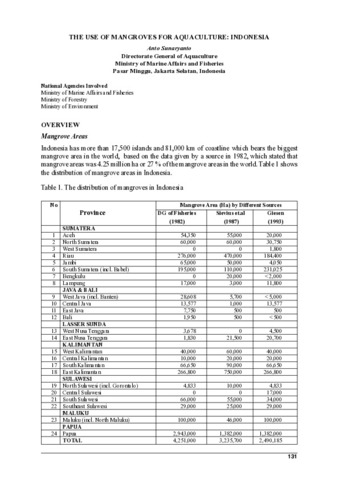The use of mangroves for aquaculture: Indonesia.
- Global styles
- MLA
- Vancouver
- Elsevier - Harvard
- APA
- Help
Share
Abstract
Indonesia has more than 17,500 islands and 81,000 km of coastline which bears the biggest mangrove area in the world, based on the data given by a source in 1982, which stated that mangrove areas was 4.25 million ha or 27 % of the mangrove areas in the world.
Later data in 1987 and 1993 the total mangrove areas were only 3.23 and 2.49 million ha, respectively, and theses have been reportedly reduced by about 1.0 and 0.8 million ha, respectively, allegedly due to aquaculture. Various sources also supply different data, but generally, the tendency of deforestation in mangrove areas is also shown.
Brackishwater pond culture was always suspected to be the main cause of the deforestation. Nevertheless, the development of brackishwater pond area does not support the allegations. From the data given by the Directorate General of Fisheries, brackishwater pond area in 1982, 1987 and 1993 are 220,400 ha, 263,200 and 331,800 ha, respectively, which means only about 22% ha (of the 1.0 million ha reduction) and 41% ha (of the 0.8 million ha reduction) may have caused the mangrove area reduction. In reality, not all of the brackishwater ponds are developed in mangrove areas as some of them are in coastal sand areas.
Suggested Citation
Sunaryanto, A. (2004). The use of mangroves for aquaculture: Indonesia. In: Promotion of mangrove-friendly shrimp aquaculture in Southeast Asia (pp. 131-135). Tigbauan, Iloilo, Philippines: Aquaculture Department, Southeast Asian Fisheries Development Center.
Type
Meeting reportCollections



